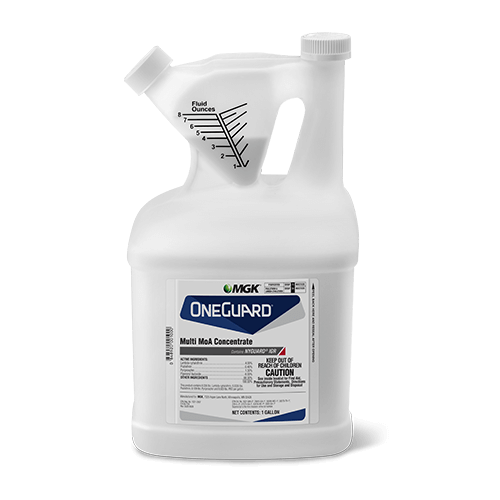Features & Benefits
- Kills mosquitoes that may transmit West Nile virus, Chikungunya virus and Zika virus
- Long-lasting control of mosquitoes
- Kills fleas and ticks
- Convenient all-in-one product
- Saves you time in the field when compared to tank-mixing multiple products
- Provides knockdown of mosquitoes
- Contains NyGuard® Insect Growth Regulator which reduces mosquito populations by preventing reproduction
- Two modes of action, combating mosquitoes at two different life stages
Resources
PMP Product Testimonial: OneGuard Multi MoA Concentrate
Del Lawson of Modern Pest Control, based out of Katy, TX, shares how the key benefits of OneGuard have helped his company boost their mosquito services 5-fold. This article first appeared in the May 2019 issue of PMP Magazine.
Product Overview: OneGuard Multi MoA Concentrate
Pest Control Protocol: Mosquitoes
A comprehensive protocol to stay in control of mosquitoes. Download, print and share.
Pest Infographic Poster: Mosquitoes
A one-page infographic that includes a mosquito description, visual, life cycle, common breeding sites, control strategies and pest facts. Download, print and share.
Pest Control Protocol: Ticks
A comprehensive protocol to stay in control of ticks including tick control product information. Download, print and share.
OneGuard® Documentation
No need to stand guard. Randy McCarty of ABC Home & Commercial Services and MGK team up to tackle mosquitoes.
“The acceptance of OneGuard by the technicians was noticed almost immediately. They loved the fact that they did not have to mix two or three products to their tanks to get control. We also noticed that the material seemed to flow out of the backpacks in a way that provided better coverage of the foliage.” – Randy McCarty, ABC Home & Commercial Services, Texas PDF Link
OneGuard® FAQs
- 1-quart bottle
- 64-ounce bottle
- 1 gallon bottle
- 30-gallon drum
Please contact your distributor for availability.
The first three stages of the mosquito lifecycle (egg, larva, pupa) are aquatic. Therefore, common places include anywhere susceptible to stagnant water:
- Bird baths
- Clogged rain gutters
- Old discarded tires
- Kiddie pools
- Flowerpots
- Saucers under potted plants
- Wheelbarrows or garden carts
- Watering cans or buckets
- Ornamental ponds
- Wood piles
- Children’s toys
- Tree holes
- Rain barrels
- Leaf piles
Aedes aegypti and Aedes albopictus differ in a few key ways that affect their control strategies:
- Small container breeders
- Only fly a few hundred meters from emergent sites
- Lay individual eggs usually near the waterline
- Eggs are laid in multiple sites (skip-oviposition); typically 100-200 eggs per batch and five batches laid in a lifetime
- Eggs can last for years and remain viable
- Active daytime biters although they will also bite at dawn and dusk

